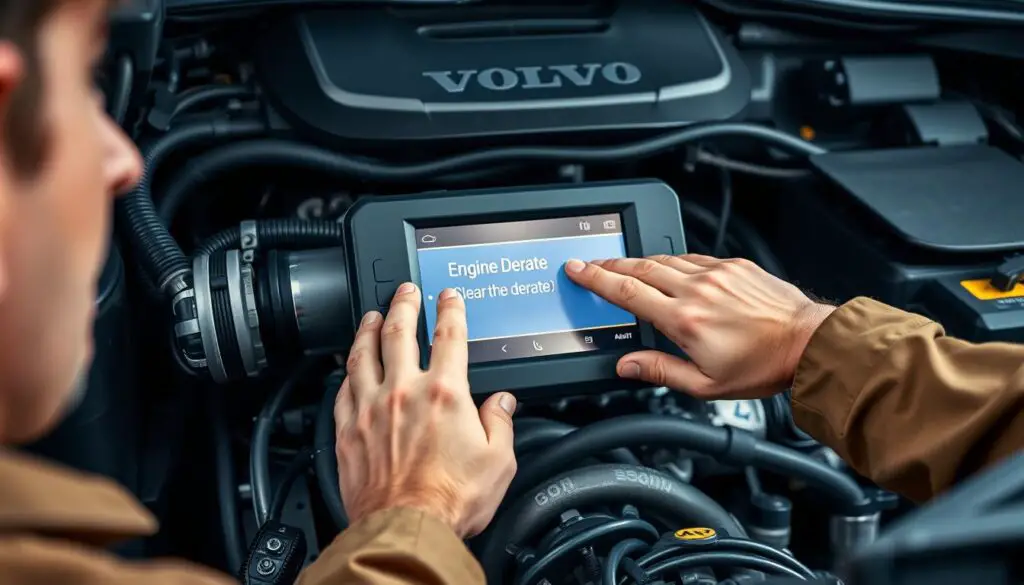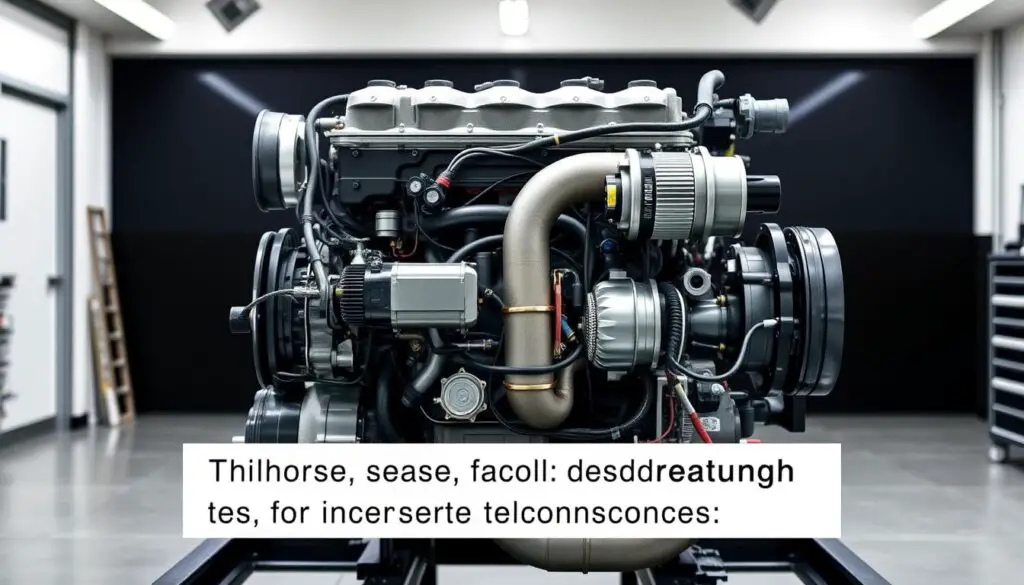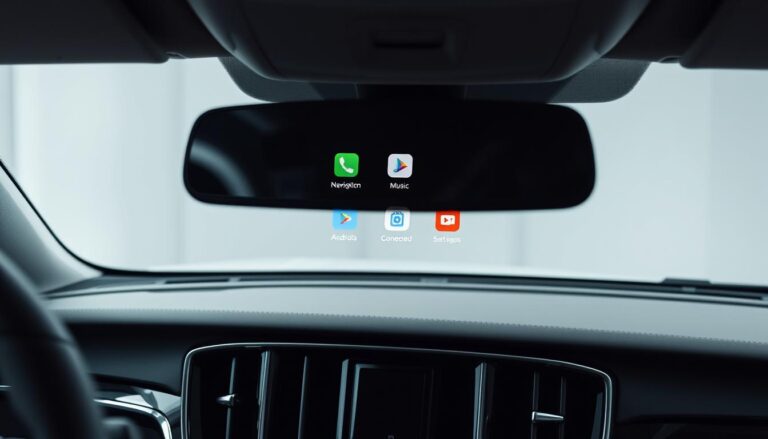Experiencing engine derate in your Volvo can be concerning, as it significantly impacts your vehicle’s performance. Volvo engine derate is a safety feature designed to prevent damage by reducing engine power. Understanding how to address this issue is crucial for maintaining your vehicle’s health and ensuring your safety on the road.
For those facing this issue, our step-by-step guide will walk you through the process of derate troubleshooting and clearing the derate condition. If you’re also experiencing a loss of power when accelerating, you may find our related article on Volvo loss of power when accelerating helpful.
Key Takeaways
- Understanding the causes of engine derate in Volvo vehicles.
- Step-by-step guide to troubleshooting derate conditions.
- Methods to clear engine derate safely.
- Preventive measures to avoid future derate issues.
- Importance of regular maintenance for optimal Volvo performance.
Understanding Engine Derate in Volvo Vehicles
Understanding engine derate is essential for maintaining the optimal performance of Volvo vehicles. Engine derate is a condition where the engine’s power output is reduced to prevent potential damage. This reduction in power can significantly impact the vehicle’s overall efficiency and performance.
What is Engine Derate and Why Does it Happen?
Engine derate is a protective mechanism triggered by the engine control module (ECM) when it detects a fault or potential problem. The ECM reduces engine power to prevent damage to the engine or other components. This can occur due to various reasons, including system malfunctions, faulty sensors, or issues with the aftertreatment system.
The derate condition is often indicated by a warning light on the dashboard, signaling that the vehicle’s performance is compromised. It is crucial to diagnose and address the underlying cause to restore the engine’s full power and prevent further damage.
Common Causes of Engine Derate in Volvo Trucks
Several factors can trigger engine derate in Volvo trucks. Common causes include issues with the aftertreatment system, faulty sensors, and problems with the ECM. Other potential causes are related to fuel system malfunctions, exhaust gas recirculation (EGR) system issues, and problems with the diesel particulate filter (DPF).
| Cause | Description | Impact |
|---|---|---|
| Aftertreatment System Issues | Problems with the aftertreatment system, such as clogged DPF or faulty SCR | Reduced engine power, increased emissions |
| Faulty Sensors | Malfunctioning sensors providing incorrect data to the ECM | Incorrect engine performance, potential derate |
| ECM Problems | Issues with the engine control module, such as software glitches or hardware faults | Engine performance issues, derate condition |
Identifying and addressing these causes is crucial for troubleshooting and resolving engine derate issues in Volvo trucks. Regular maintenance and timely repairs can help prevent derate conditions and maintain optimal engine performance.
Tools and Preparation for Clearing Engine Derate
Before attempting to clear engine derate on your Volvo truck, it’s crucial to have the right tools and preparation in place. This not only ensures the process is done efficiently but also safely.
Essential Diagnostic Tools for Volvo Trucks
To diagnose and clear engine derate, you’ll need specific diagnostic tools. The most commonly used tools include:
- Volvo Tech Tool: A comprehensive diagnostic tool designed for Volvo trucks, allowing for detailed diagnostics and programming.
- Electronic Service Tool (EST): Used for diagnosing and troubleshooting issues within the engine and other systems.
These tools help in identifying the root cause of the derate and facilitate the necessary repairs.
Safety Precautions Before Starting
Safety should always be your top priority. Before starting, ensure you:
- Wear appropriate personal protective equipment (PPE) such as gloves and safety glasses.
- Ensure the truck is parked on a level surface and apply the parking brake.
- Follow proper lockout/tagout procedures to prevent accidental engine start.
Taking these precautions helps prevent accidents and injuries during the repair process.
Accessing the Engine Control Module on Different Volvo Models
The Engine Control Module (ECM) is a critical component in diagnosing engine derate. The location of the ECM can vary between different Volvo models. Typically, it is found under the cab or on the driver’s side of the engine compartment. Consult your truck’s manual or a repair guide specific to your Volvo model to locate the ECM.
Once located, use your diagnostic tools to connect to the ECM and retrieve any fault codes related to the derate condition.
Step-by-Step Process to Clear Engine Derate on a Volvo
Clearing engine derate on a Volvo truck requires a systematic approach to diagnose and rectify the underlying issues. This process involves several key steps that must be executed in a specific order to ensure the problem is resolved effectively.
Connecting Diagnostic Equipment to Your Volvo
To begin, you’ll need to connect diagnostic equipment to your Volvo truck. This typically involves using a device such as a J1939 cable connected to a laptop or a dedicated diagnostic tool. The equipment should be compatible with your Volvo’s engine control module (ECM) to read and clear fault codes accurately.
Ensure the diagnostic tool is properly connected to the truck’s ECM, usually located under the dashboard or in the engine compartment, depending on the Volvo model.

Reading and Identifying Fault Codes
Once connected, the diagnostic tool will read the fault codes stored in the ECM. These codes are crucial for understanding why the engine derate occurred. Common fault codes related to derate include issues with the aftertreatment system, fuel system, or engine sensors.
It’s essential to carefully note down the fault codes and their descriptions to identify the root cause of the derate.
Common Volvo Error Codes and Their Meanings
Some common error codes associated with engine derate on Volvo trucks include:
- SPN 5246 FMI 0: This code indicates a high soot load in the diesel particulate filter (DPF).
- SPN 4364 FMI 18: This suggests an issue with the selective catalytic reduction (SCR) system, potentially related to low DEF quality or a faulty NOx sensor.
Clearing the Fault Codes
After identifying the fault codes, the next step is to clear them using the diagnostic tool. This process involves following the tool’s on-screen instructions to delete the stored codes. However, clearing fault codes without addressing the underlying issue can lead to the derate returning.
Resetting the Engine Control Module
Resetting the ECM may be necessary after clearing fault codes. This can usually be done through the diagnostic tool or by disconnecting the truck’s battery for a few minutes. Resetting the ECM allows it to relearn and recalibrate, potentially resolving the derate issue.
Verifying the Derate Has Been Cleared
Finally, after completing the above steps, it’s crucial to verify that the engine derate has been cleared. This involves checking the dashboard for any warning lights related to derate and using the diagnostic tool to confirm that the ECM is no longer in derate mode.
Test driving the truck under various conditions can also help ensure that the derate has been successfully cleared and that the truck is operating normally.
Troubleshooting Persistent Derate Issues in Volvo Engines
Persistent derate issues in Volvo engines can be efficiently addressed through systematic troubleshooting. Derate conditions can significantly impact the performance and efficiency of your vehicle, leading to potential downtime and increased maintenance costs.
Aftertreatment System Problems and Solutions
The aftertreatment system is a critical component in modern diesel engines, including Volvo models, designed to reduce emissions. Issues within this system can trigger derate conditions. Common problems include:
- Clogged Diesel Particulate Filter (DPF)
- Faulty Selective Catalytic Reduction (SCR) system
- Malfunctioning sensors
For instance, a clogged DPF can cause significant backpressure, leading to a derate condition. To resolve this, you may need to perform a DPF regeneration or replace the filter if it’s damaged beyond cleaning. For more detailed guidance, you can refer to resources like this article on handling a Volvo D13 stuck in 5 mph derate.
| Issue | Symptoms | Solution |
|---|---|---|
| Clogged DPF | High backpressure, reduced engine performance | DPF regeneration or replacement |
| Faulty SCR | Emissions warnings, derate condition | Inspect and repair or replace SCR components |
When to Seek Professional Help
While some derate issues can be resolved with basic troubleshooting, complex problems may require professional assistance. If you’ve attempted to clear the derate and the issue persists, it’s advisable to seek help from a certified mechanic or a Volvo dealership. They have the necessary diagnostic tools and expertise to identify and fix complex issues.
“The complexity of modern engine systems means that while some issues can be diagnosed and fixed by experienced DIY mechanics, others require the specialized knowledge and equipment of a professional.”
Preventive Maintenance to Avoid Future Derates
Regular maintenance is key to preventing derate conditions. This includes:
- Regularly checking and maintaining the aftertreatment system
- Performing timely oil changes and filter replacements
- Monitoring engine performance and addressing any issues promptly
By staying on top of maintenance, you can significantly reduce the risk of derate conditions occurring in the future. Additionally, using high-quality fuels and lubricants can help maintain the health of your engine.

Conclusion
Clearing engine derate on a Volvo is a vital process that ensures the optimal performance and longevity of the vehicle. As discussed, engine derate can occur due to various reasons, including aftertreatment system problems or faulty sensors. By following the step-by-step guide outlined in this article, Volvo truck owners can effectively troubleshoot and clear engine derate issues.
Proper Volvo truck repair involves not only addressing the immediate issue but also taking preventive measures to avoid future derates. Regular maintenance, including checking and cleaning the aftertreatment system, can significantly reduce the likelihood of engine derate. By understanding the causes and solutions to engine derate, owners can minimize downtime and maintain their trucks’ efficiency.
Engine derate troubleshooting is a critical skill for Volvo truck owners, enabling them to identify and resolve issues promptly. By applying the knowledge gained from this article, owners can ensure their vehicles operate at peak performance, reducing the need for costly repairs and maintaining overall productivity.
FAQ
What is engine derate and how does it affect my Volvo truck?
Engine derate is a condition where the engine’s performance is reduced to prevent damage. It can be caused by various factors, including faulty sensors, software issues, or problems with the aftertreatment system. Clearing engine derate on a Volvo requires diagnostic tools and a step-by-step process.
Can I clear engine derate on my Volvo without professional help?
Yes, you can clear engine derate on your Volvo using diagnostic equipment and following the correct procedure. However, if you’re not familiar with the process or if the issue persists after attempting to clear it, it’s recommended to seek help from a certified mechanic or a Volvo dealership.
What are the common causes of engine derate in Volvo trucks?
Common causes of engine derate in Volvo trucks include issues with the aftertreatment system, faulty sensors, software problems, and clogged diesel particulate filters. Identifying the root cause is crucial to clearing the derate and preventing future occurrences.
How do I access the engine control module on my Volvo?
Accessing the engine control module (ECM) on a Volvo varies depending on the model. Typically, it involves locating the ECM under the hood or in the cab, then connecting diagnostic equipment to read and clear fault codes.
What diagnostic tools do I need to clear engine derate on my Volvo?
To clear engine derate on a Volvo, you’ll need a compatible diagnostic tool, such as the Volvo diagnostic tool or a third-party equivalent, to read and clear fault codes, and reset the ECM.
How can I prevent engine derate from happening again in the future?
Regular maintenance, including software updates, cleaning or replacing clogged filters, and addressing any issues promptly, can help prevent engine derate. Additionally, monitoring your truck’s performance and addressing any warning signs early on can also help prevent derate.



